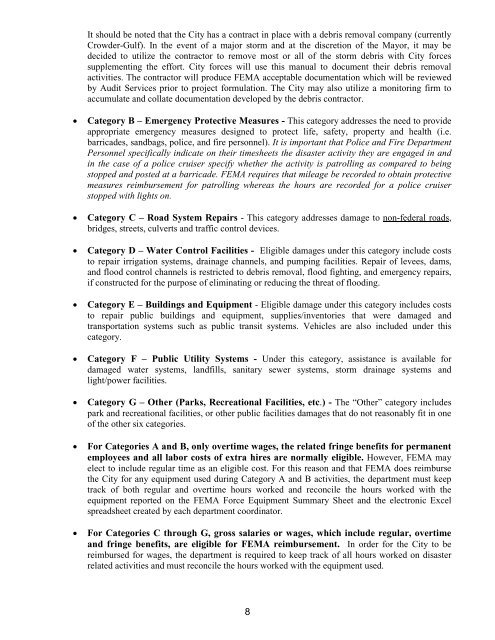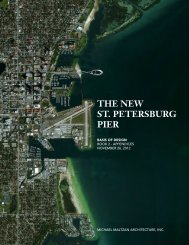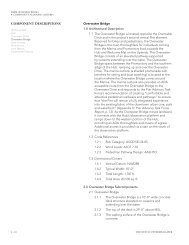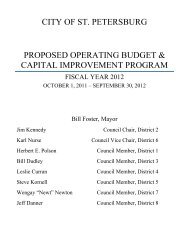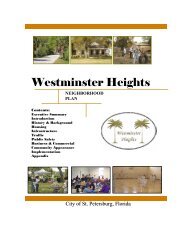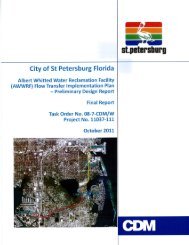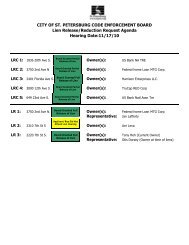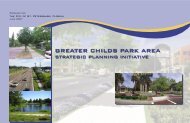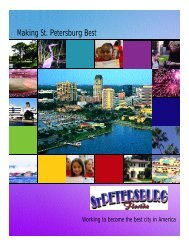Disaster Cost Reimbursement Manual City of St. Petersburg
Disaster Cost Reimbursement Manual City of St. Petersburg
Disaster Cost Reimbursement Manual City of St. Petersburg
You also want an ePaper? Increase the reach of your titles
YUMPU automatically turns print PDFs into web optimized ePapers that Google loves.
It should be noted that the <strong>City</strong> has a contract in place with a debris removal company (currently<br />
Crowder-Gulf). In the event <strong>of</strong> a major storm and at the discretion <strong>of</strong> the Mayor, it may be<br />
decided to utilize the contractor to remove most or all <strong>of</strong> the storm debris with <strong>City</strong> forces<br />
supplementing the effort. <strong>City</strong> forces will use this manual to document their debris removal<br />
activities. The contractor will produce FEMA acceptable documentation which will be reviewed<br />
by Audit Services prior to project formulation. The <strong>City</strong> may also utilize a monitoring firm to<br />
accumulate and collate documentation developed by the debris contractor.<br />
• Category B – Emergency Protective Measures - This category addresses the need to provide<br />
appropriate emergency measures designed to protect life, safety, property and health (i.e.<br />
barricades, sandbags, police, and fire personnel). It is important that Police and Fire Department<br />
Personnel specifically indicate on their timesheets the disaster activity they are engaged in and<br />
in the case <strong>of</strong> a police cruiser specify whether the activity is patrolling as compared to being<br />
stopped and posted at a barricade. FEMA requires that mileage be recorded to obtain protective<br />
measures reimbursement for patrolling whereas the hours are recorded for a police cruiser<br />
stopped with lights on.<br />
• Category C – Road System Repairs - This category addresses damage to non-federal roads,<br />
bridges, streets, culverts and traffic control devices.<br />
• Category D – Water Control Facilities - Eligible damages under this category include costs<br />
to repair irrigation systems, drainage channels, and pumping facilities. Repair <strong>of</strong> levees, dams,<br />
and flood control channels is restricted to debris removal, flood fighting, and emergency repairs,<br />
if constructed for the purpose <strong>of</strong> eliminating or reducing the threat <strong>of</strong> flooding.<br />
• Category E – Buildings and Equipment - Eligible damage under this category includes costs<br />
to repair public buildings and equipment, supplies/inventories that were damaged and<br />
transportation systems such as public transit systems. Vehicles are also included under this<br />
category.<br />
• Category F – Public Utility Systems - Under this category, assistance is available for<br />
damaged water systems, landfills, sanitary sewer systems, storm drainage systems and<br />
light/power facilities.<br />
• Category G – Other (Parks, Recreational Facilities, etc.) - The “Other” category includes<br />
park and recreational facilities, or other public facilities damages that do not reasonably fit in one<br />
<strong>of</strong> the other six categories.<br />
• For Categories A and B, only overtime wages, the related fringe benefits for permanent<br />
employees and all labor costs <strong>of</strong> extra hires are normally eligible. However, FEMA may<br />
elect to include regular time as an eligible cost. For this reason and that FEMA does reimburse<br />
the <strong>City</strong> for any equipment used during Category A and B activities, the department must keep<br />
track <strong>of</strong> both regular and overtime hours worked and reconcile the hours worked with the<br />
equipment reported on the FEMA Force Equipment Summary Sheet and the electronic Excel<br />
spreadsheet created by each department coordinator.<br />
• For Categories C through G, gross salaries or wages, which include regular, overtime<br />
and fringe benefits, are eligible for FEMA reimbursement. In order for the <strong>City</strong> to be<br />
reimbursed for wages, the department is required to keep track <strong>of</strong> all hours worked on disaster<br />
related activities and must reconcile the hours worked with the equipment used.<br />
8


